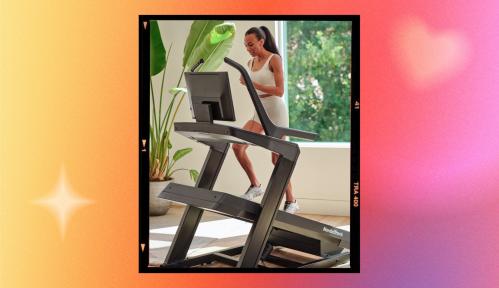Our editors independently select these products. Making a purchase through our links may earn Well+Good a commission
Wait, Should I Be Salting My Yoga Mat?
Hate a slip-slidey yoga mat? The fix might be in your pantry. Grab a box of sea salt, and learn how to do some salt scrubbing to your yoga mat.

Nothing is worse than stepping onto your brand-new yoga mat, ready to feel grounded during a workout—only to slip and slide while flowing through sun salutations and other sweat-inducing sequences. It turns out, adding a little salt can help you get a grip.
Experts in This Article
SVP of product at yoga apparel and equipment brand Manduka
Atlanta-based yoga instructor
The right no-slip yoga mat keeps the body grounded and aligned while providing much-needed cushioning for joints and muscles. However, most mats are made from PVC (polyvinyl chloride) or coated with protective seals to keep them from sticking together during manufacturing and give them long-term durability, both of which can make the surface slippery during the first few uses. Others are designed with a closed-cell surface—great for keeping moisture and debris out, but more challenging for traction during a sweaty class.
Add in heated practice rooms and residual body oils and lotions, and even the highest quality mat can initially feel slick and unstable.
Many yogis swear by a new viral trend—salt-scrubbing—to give their mats added grip and stickiness.
“Salt is a great way to break that initial barrier of the ‘new mat feeling,’ and I recommend doing it at least twice within the first month of practicing on your new mat,” says Atlanta-based yoga instructor Freya Locklair, E-RYT 200, RYT 500, YACEP.
“I recommend doing it at least twice within the first month of practicing on your new mat.”—Freya Locklair, RYT 500
Christian Regester, SVP of product at yoga apparel and equipment brand Manduka, says the brand recommends the salt scrub method to break in its PVC-based PRO and other mats. Here’s how to salt scrub a yoga mat:
- Sprinkle coarse sea salt on top of mat
- Leave it to set for 24 hours
- Scrub in salt using a washcloth with a small amount of water
- Wipe the mat clean and hang it to dry
How does salt-scrubbing a yoga mat work?
“Salt and sweat break down the top layer of the mat, so the material becomes more porous and better able to absorb sweat and create traction,” says Locklair. “Over time, you will see the difference in the areas of your mat where you place your hands and feet, because they will have more of a matte look because the top layer has worn down.”
She recommends speeding up the breaking-in process by showering before class to remove residual body and hair products and using yoga mat sprays and other cleansers sparingly on new mats.
“Cleaning removes the sweat that is beneficial in giving your mat that ‘grippy’ feeling, which leads to a safer and more stable asana practice,” she explains. “Also, some cleaners leave behind a residue that can make mats sticky and unstable.”
Instead, she recommends wiping off excess moisture after practice and hanging your mat to air dry indoors, giving time for sweat and salt time to fully absorb and add tackiness to the surface.
Some mat materials are slippier or require more salting than others, so she suggests shopping around for the right mat for your particular yoga practice. Locklair prefers an open-cell style mat (like the B Yoga Everyday Mat or Iuga Pro Mat) for hot yoga classes because they need “very little breaking in and provide more traction.” But those types of mats do trap debris and moisture, so they need to be cleaned and replaced more frequently than closed-cell mats (like Manduka’s Pro and eKO mats.) The latter also are great for slower-paced gentle and restorative classes, when you’re less likely to sweat.
And if you do find yourself sliding around on a new mat, both Locklair and Regester both recommend using a performance yoga towel to absorb excess moisture and add traction for sweaty palms and feet.
“However, a towel does prevent your sweat from seeping into the mat and prevents the natural breakdown of the top layer,” says Locklair. A good compromise? Starting class without a mat towel, and then putting one down when the surface becomes slippery.
Ultimately, just like nailing that elusive pose or breathing through a difficult asana, breaking in your new mat requires time, patience, and practice.
Sign up for the Well+Good SHOP Newsletter
Get exclusive deals on wellness, beauty, fitness, and food products that have been hand-picked by our editors.
Got it, you've been added to our email list.










